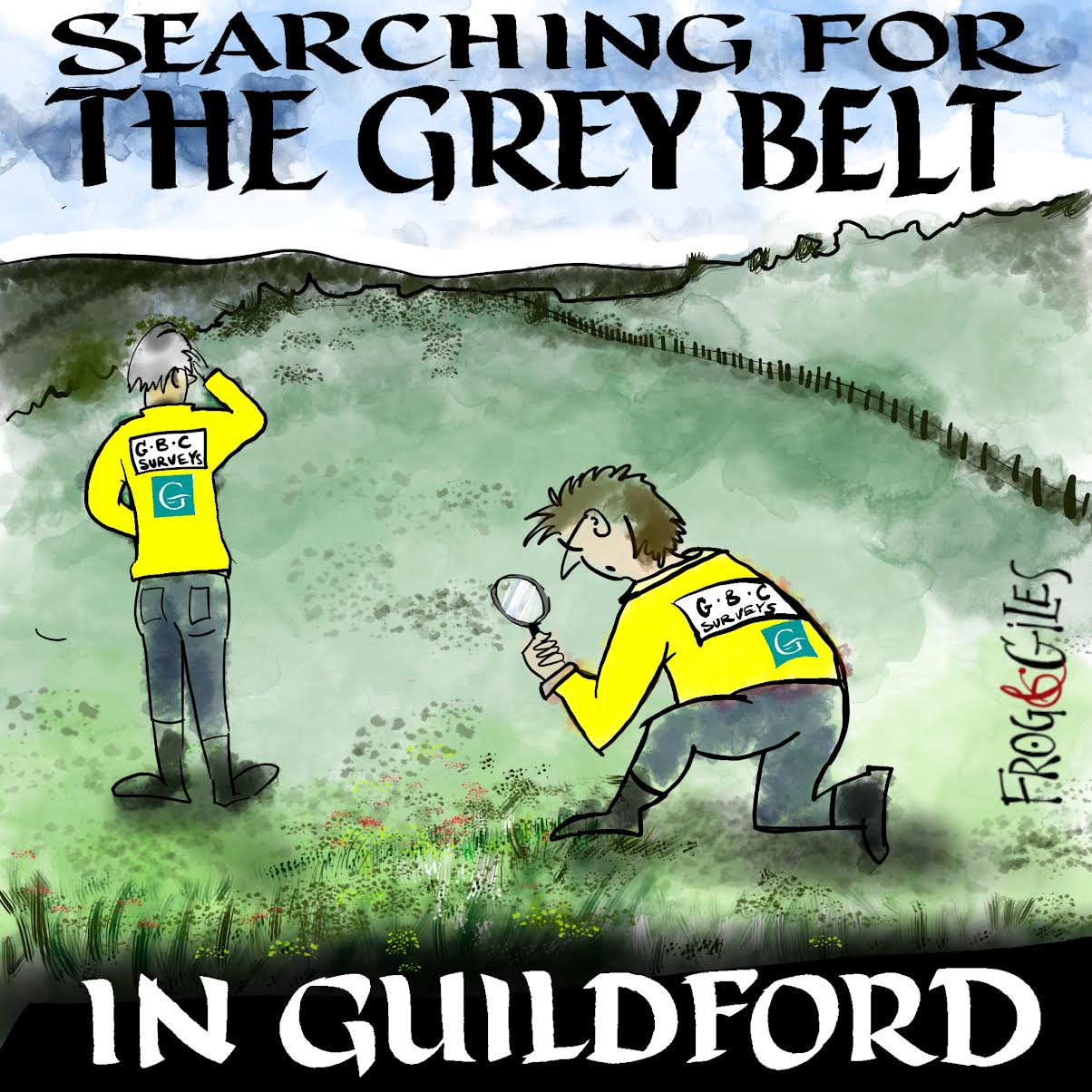 Abraham Lincoln
If given the truth, the people can be depended upon to meet any national crisis...
Abraham Lincoln
If given the truth, the people can be depended upon to meet any national crisis...
 Guildford news...
for Guildford people, brought to you by Guildford reporters - Guildford's own news service
Guildford news...
for Guildford people, brought to you by Guildford reporters - Guildford's own news service
Letter: Never Mind the Ding-Dong, What About the Traffic?
Published on: 19 Oct, 2017
Updated on: 19 Oct, 2017
From Bibhas Neogi
Enough of the ding-dong affair. It is urgent that the councils give traffic issues the attention they need.
On Tuesday, (Oct 17) I drove on the A281 to Worth, near Crawley, to attend a conference. Traffic going towards Guildford queued all the way back to Cranleigh! I was lucky to be going in the opposite direction.
There were no roadworks, no incident nor any accident – the jam was purely due to the volume of traffic. Surely such severe congestion is unacceptable. Lost working time and increased pollution are both detrimental result of such congestion. When will the councils bite the bullet and do something to reduce such severe congestion?
Do build tunnels and bridges and charge motorists for their use if the Department for Transport would not fund the schemes fully. Building more houses, especially in Dunsfold will only add to the traffic on the A281.
The Department for Communities & Local Government should not expect councils to build new homes when the Department for Transport appears not to be funding the necessary road infrastructure. Let’s have some joined-up thinking.
Responses to Letter: Never Mind the Ding-Dong, What About the Traffic?
Leave a Comment Cancel replyPlease see our comments policy. All comments are moderated and may take time to appear. Full names, or at least initial and surname, must be given.

"Found any?" - "Nope, it all looks green to me!" (See Opinion: The Future is Congested, the Future is Grey)




Recent Articles
- Big Leaf Foundation Wins King’s Award for Voluntary Service
- Notice: Premises Licence for Retailing Alcohol at Walnut Unimart
- Letter: I Invite Guildford’s MP to See the ‘Orgy of Housebuilding’ Before Infrastructure Improvements
- Threats to Staff and Fly-tipping Result in Closure of Recycling Centre
- Ash Level Crossing Will Not Close in December, SCC Assures Residents
- Sara Sharif Trial Latest – The Judge Reviews the List of 71 Injuries Found on Sara
- Column: Guildford’s MP Writes – Championing the Needs of Guildford and Our Villages
- City Win at Last With Three Penalties in Cup Tie
- Letter: Development of Gosden Hill Could Be an Opportunity for Improvement
- Ash Level Crossing Row: GBC Rejects Cabinet Member’s Statement As ‘Factually Incorrect’


Recent Comments
- Warren Gill on Ash Level Crossing Row: GBC Rejects Cabinet Member’s Statement As ‘Factually Incorrect’
- Olly Azad on Heartbreak for City Again as Two Extra-time Goals Snatch Victory
- Brian Holt on Heartbreak for City Again as Two Extra-time Goals Snatch Victory
- Helen Skinner on County Council Cabinet Confirms Its Decision on London Road Scheme
- John Oliver on County Council Cabinet Confirms Its Decision on London Road Scheme
- John Ferns on Ash Level Crossing Row: GBC Rejects Cabinet Member’s Statement As ‘Factually Incorrect’
Search in Site
Media Gallery
Dragon Interview: Local Artist Leaves Her Mark At One of England’s Most Historic Buildings
January 21, 2023 / No Comment / Read MoreDragon Interview: Lib Dem Planning Chair: ‘Current Policy Doesn’t Work for Local People’
January 19, 2023 / No Comment / Read MoreA3 Tunnel in Guildford ‘Necessary’ for New Homes, Says Guildford’s MP
January 10, 2023 / No Comment / Read More‘Madness’ for London Road Scheme to Go Ahead Against ‘Huge Opposition’, Says SCC Leader
January 6, 2023 / No Comment / Read MoreCouncillor’s Son Starts Campaign for More Consultation on North Street Plan
December 30, 2022 / No Comment / Read MoreCounty Council Climbs Down Over London Road Works – Further ‘Engagement’ Period Announced
December 14, 2022 / No Comment / Read MoreDragon Interview: GBC Reaction to the Government’s Expected Decision to Relax Housing Targets
December 7, 2022 / No Comment / Read MoreHow Can Our Town Centre Businesses Recover? Watch the Shop Front Debate
May 18, 2020 / No Comment / Read More







Simon Schultz
October 19, 2017 at 3:01 pm
Won’t building tunnels and bridges just funnel cars into the next blockage, potentially making the problem even worse? (see e.g. this nice article in Wired a few years ago: https://www.wired.com/2014/06/wuwt-traffic-induced-demand/). Why not just charge motorists to use the roads in the first place, per road; that may at least work on the demand side of the equation.
Dave Middleton
October 19, 2017 at 5:10 pm
Motorists already pay to use the road:
Vehicle Excise Duty (“Road Tax”)
VAT on fuel
Fuel Duty
VAT on Fuel Duty
VAT on the purchase of the Car / Motorcycle / other vehicle
VAT on spare parts
VAT on servicing costs
Insurance Premium Tax
There’s probably more that I can’t remember at the moment.
Jules Cranwell
October 19, 2017 at 5:30 pm
Our council is doing something about traffic and pollution. They are adding at least another 50,000 cars to our roads with their discredited local plan.
If you think it’s bad now, “You ain’t seen nothin’ yet!”
Jim Allen
October 19, 2017 at 5:44 pm
Why not allow single-occupant vehicles to only use slow lane?
At current levels of predicted traffic increase the A3, in the next ten years, will require four lanes in each direction from Compton to J10.
A tunnel could provide the extra capacity if the A3 was widened to four lanes on each carriageway. The £1.4 billion costing would be repaid within five years on travel time savings alone.
Or we could simply disinvent the motor car and return to horse and carts. Although in 1817 in London they had a problem with horse manure causing pollution problems.
Valerie Thompson
October 19, 2017 at 6:07 pm
The A281 will be much worse when all the Cranleigh development is done and everyone funnels onto the main road to go to work or school or to shop.
We already pay for using the roads with road tax. Please don’t suggest we pay more.
Bibhas Neogi
October 19, 2017 at 7:10 pm
It depends on the state of the road network. Tunnels and bridges carrying traffic away from the congested areas obviously need to discharge at points of the network where there are extra capacities to cope with the influx.
Here in Guildford, Highways England is working on the widening and improving the A3. We do not yet know what they are going to propose but assuming the widening will be done, a tunnel, for example, from the A281 with a link to the A3100 would take traffic out of Guildford town centre to Parkway on the A25, then to the A3, then to the A320, also to the A322 and the A246. Without the tunnel, this traffic has to go through the town centre, Woodbridge Road and York Road.
Charging motorists without giving them a viable alternative route could not be justified. In Guildford, there are no viable alternative routes to avoid the town centre. So charging may deter a few motorists but would not significantly reduce congestion and such a measure would then be viewed as revenue raising by the council.
It is true that improvements and widening of roads generate some traffic but the planners have to take that into account. Forecasting traffic is a complex exercise especially when more and more work and businesses are being carried on the internet and thus reducing the need to physically meet up.
Subsidising public transport by the government, as many EU countries do, also helps to reduce car usage since higher fares discourage their use as the motorists have already invested in buying cars, insuring and taxing them. The Department for Transport spends less than 20% of the revenues it raises on road network improvements and maintenance.
So, it is really up to the central government to consider changing the funding criteria and fund roads infrastructure adequately. Congestion costs the country in wasted resources and it affects the overall efficiency of the economy.
Calum Shaw
October 20, 2017 at 6:49 am
Build more roads, more people will drive.
Build more railways, more people will take the train.
Build more cycle tracks, more people will walk and cycle
In our crowded land, it’s generally best to invest in the options that give the highest density of traveller transfer (so not roads). That way some people will get out of the way of your car and you will have a more efficient journey. (It was probably most appropriate for your journey to have been by car.)
Simon Schultz
October 20, 2017 at 1:04 pm
To spell out more clearly, what I would recommend is to titrate the charge against the amount of traffic.
At a sufficiently high charge, the traffic will reduce. Yes, I understand that this threshold may be very high. But this would then drive innovation in things like delivery networks, which are currently highly suboptimal with regard to the use of the road resources they currently get for free. I would exempt only the emergency services.
Once innovation had occurred, the charge could possibly be reduced.
I fully understand that my proposal is far too radical to be politically viable, but I do believe it would solve the problem entirely, given that very few people really need to drive cars, if you look at the big picture.
John Robson
October 20, 2017 at 4:27 pm
There’s plenty of room in this country if you move the epicentre of the universe away from London and the South-East.
The Tories trashed the North and now they’ve done the same to the South, despite the billions squandered on infrastructure to the Tory party sponsors we’ve reached saturation point.
The future billions earmarked for infrastructure expenditure isn’t going to change that, look at the M25 for as evidence.
Mind you, from Guildford’s perspective, once Cllr Spooner gets a Chinese contractor to put the A3 in a tunnel, I may have to eat humble pie.
Adam Aaronson
October 22, 2017 at 8:16 am
If I understand Simon Schultz’s proposal correctly, he is saying that traffic can be managed by restricting car use to those who can afford it – ie rich people, “given that very few people really need to drive cars”.
I agree that many people make car journeys that are not always necessary. However, this proposal could only be viable once the capacity of the public transport system is vastly increased.
Until then, how are poor people going to travel? Will their employers pay them extra to enable them to pay the road charge? Or should they just get up earlier to get to work on time?
Brian Holt
October 22, 2017 at 9:04 pm
I keep reading comments about building tunnels under Guildford for through traffic, but how much land would be needed to build one? Just look how much land was required to build Hindhead tunnel. There would be all the offices needed for engineers, a very large site to store all the heavy equipment, parking for all the people working on the site, and space for the many tipper trucks and other plant that would be needed.
Also they would need a large site, when boring the tunnel, to store the earth being removed.
The people who suggest tunnels should explain where there would be room for such a site in Guildford.
Bibhas Neogi
October 22, 2017 at 10:27 pm
I would suggest that Brian Holt sees the sketches on my website http://www.spanglefish.com/revampguildfordgyratory and the associated notes that explain how to use the spoil from the tunnel to build the connecting links.
The tunnel I suggested for the A281 to the A25 Parkway has its southern portal off the existing road and the embankments for the links could be built using the spoil, thus reducing the need to carry away the bulk of the excavation.
Jim Allen
October 23, 2017 at 9:06 am
It is very simple to answer Brian Holt. The solution tunnel (not a mitigation proposal) would go from Gosden Hill to Compton, providing a 1,000 car spare capacity on the A3 per hour in ten years time.
The tunnel would start at 30m above sea level drop to 20 and rise to 80 at Compton, the cost would be approximately £1.4 billion repaid by removal of delays in five years. At 8.2km long, it would involve two landowners (so less legal delays than a bypass 12.5km with over 25 landowners and 500 vehicles per hour short of capacity within ten years).
The land required at Gosden has already been allocated for removal from the green belt. There is space at both ends for offices – the tunnel itself could be dug in approximate 271 days, post planning and prior to fitting out. On a practical engineering level there is no problem – it is the politics and the finances which are the major problems.
Personally, I’d prefer no omelette but if you want one you have to break the eggs.
John Robson
October 24, 2017 at 3:33 pm
The government found £1.2bn to build a tunnel past Stonehenge to pacify a few hippies.
Where’s the issue in finding the cash for the UK’s economic powerhouse that is Surrey?
Guildford’s MP is supposedly lobbying the government, of which she is a part, for funds.
The leader of the council might have taken the investment case to pay for a tunnel to his new buddies in China.
We’re paralysed by fear and inaction in this country. I say, get it built.
Colin Cross
October 23, 2017 at 12:49 am
Tunnels are mega-expensive but flyovers are not and they are much quicker to install. Why not build a flyover above the existing one and make it purely for through-traffic?
No need for on/off slips etc as that would all still be done on the existing flyover level. Put simply, the vehicles not wanting Guildford would use the upper, direct tier and the local traffic will continue to come on and off the lower tier. My guess is it splits 50/50.
Obviously, it would not be without some pain to certain areas but it is cheaper, quicker and more realistic than anything on the table at present.
We simply can’t wait a decade or more to sort this out. Any other ideas?
Colin Cross is the Lib-Dem borough councillor for Lovelace.
Bibhas Neogi
October 24, 2017 at 1:52 pm
The idea of a viaduct was mentioned by me, and possibly others, in the discussions that took place here on The Dragon. I quote from my comment on March the 13th 2015: “All these ideas and much more are described on my website that could be found by searching for, “revamp Guildford gyratory”.
It is technically possible to build a two-lane viaduct from Burpham to Compton that could take through traffic and could operate as a tidal route. A 9km long viaduct 10 metres wide would cost £350-400m but would we want such a dominating structure through Guildford?
The post and the comments are from October 13, 2013, onwards http://www.guildford-ragon.com/2013/10/12/letter-ideas-affordable-road-tunnels/
Colin Reardon
October 23, 2017 at 6:21 pm
What a visionary decision it was to close the Guildford to Cranleigh rail line in 1965. Not!